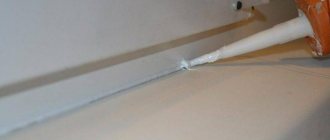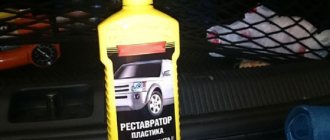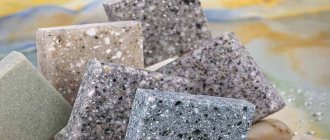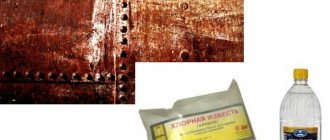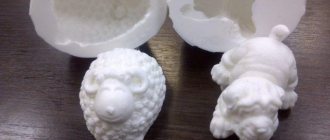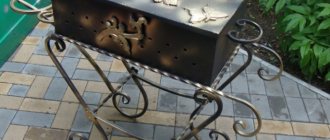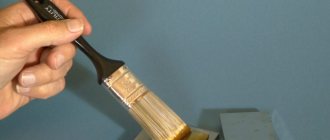Liquid plastic
Problems of corrosion, rotting and destruction from moisture are some of the most common problems encountered during the operation of buildings, structures, engineering structures, and various equipment.
Nowadays, many methods have been developed to combat them. All methods differ from each other not only in cost, but also in efficiency and service life. This article describes a new effective material for waterproofing any type of surface. Polymer coating “Liquid plastic” is intended to protect products made of wood, metal, stone from moisture and precipitation. The coating is chemically resistant to a large number of aggressive liquids and gases. “Liquid plastic” contains a stabilizer that prevents the destruction of the coating from ultraviolet radiation (for example, it does not deteriorate in the sun).
“Liquid plastic” is a transparent liquid with a viscous consistency. Supplied in plastic bottles of 1, 5, 10 liters. Tinted “Liquid Plastic” is also available in the following colors: pine, oak, teak, chestnut, tobacco, mahogany, rosewood, cherry, larch, walnut, maple. Tinting “Liquid plastic” is mainly used for treating wooden surfaces. The tinting coating is translucent, uniform, and preserves the structure of the wood.
It is possible to tint colorless liquid plastic in any color using natural fillers (for example, metal powders) or iron oxide professional colors. In the case of tinting “Liquid plastic” with water-based tinting pastes, it is recommended to tint small volumes of plastic in order to avoid “folding” of the material in volume.
Scope of application of “Liquid plastic”:
Features of the Liquid Plastic coating:
Requirements for the surface protected by “Liquid Plastic”:
What is missing among modern building materials, for example, there is liquid glass, liquid nails, and so on, and there is also liquid wood . What it is, what it is used for and what varieties of this type of material exist is not known to everyone.
Areas of application of plastic paint
Paint with liquid plastic is suitable for wood, drywall, brick, concrete. Using plastic paint, walls and ceilings are prepared for wallpaper and final painting. Liquid polymer is used in the following areas:
- construction;
- Finishing work;
- Automotive industry;
- shipbuilding.
Polymer paint is used to apply car markings on city streets and highways. Liquid plastic is used to paint water and gas pipes, fences, gates, and metal safes. Enamel with polyurethane, acrylic and alkyd protects surfaces from precipitation and ultraviolet radiation. It is also used to cover wooden architectural decorations and balconies.
Expert opinion
Zakharova Irina Yurievna
Cleaning professional with 15 years of experience. Our best expert.
Ask a Question
Use acrylic paint for metal to restore the coating of the bathtub. A durable film fills cracks and protects against fungus. It is used for interior and exterior work.
Description and properties
Liquid wood paint is essentially a composite, that is, a material obtained by mixing polymer resin with wood flour. This type of material is “ecological”, that is, it is made from logging waste and a number of others, for example, “ liquid glass for wood ”, as this material is sometimes called, can contain completely different components - straw, wood husks, crushed hemp, cork flour, shells and much more.
The polymer plays the role of a base and a binding component; it can be any thermally plastic synthetic resin; polypropylene, polyvinyl chlorides, polyethylene resins and other similar elements can be added.
Among the properties characterizing liquid wood coating , the following should be highlighted:
- when hardened, the material becomes completely indistinguishable in appearance from natural wood;
this material practically does not interact with the external environment, and therefore does not deteriorate;
does not emit any substances harmful to human health, since it does not contain formaldehyde or any other impurities;
this type of material is highly resistant to all types of mechanical influences; it is extremely difficult to even scratch it with anything sharp;
temperature fluctuations, within which liquid wood does not change, range from -50 degrees to +180 on the Celsius scale;
this material is a modified polymer, so it is absolutely not afraid of fungus, insects, humidity, or any other “external threats”, that is, treating wood “ liquid glass ” will make the wooden element almost eternal;
for products processed with liquid wood, absolutely no other processing or painting will be required;
using the material not as a coloring material, but simply pouring it into a mold, you can get a product that is indistinguishable from wood, but completely devoid of all its shortcomings;
- the color does not change even under prolonged direct exposure to ultraviolet rays, this allows you to decorate with this material any rooms with fluorescent or ultraviolet light, for example, the halls of night clubs, or simply decorate a garden area that is under constant “sun.”
Liquid wood simply does not have any disadvantages as such; the only thing you will have to face if you want to use this material is the need to carefully familiarize yourself with the composition and preferred intended use, all of which is indicated on the labels by the manufacturers.
Application
Liquid wood can be used as a covering or finishing material, or as a finished product. In the second option, for example, in stores or in building materials catalogs, the abbreviation “DPK” is used for designation.
use a material such as liquid plastic for wood without any restrictions, just like regular paint. The only thing you shouldn’t do is use it in rooms where the temperature can exceed +180 degrees, or drop below -50, but in practice such places are very rare, even in large “rooms” deep-freezing refrigerators the temperature is above 50 degrees , and in the hottest sauna it never rises to 180.
Silicone coloring procedure
If you choose the subsurface tinting method, remember that it is advisable to use it when making silicone decor, and not molds for the production of epoxy resin products. The work will have to be carried out in two stages. First, silicone tinted with pigment is applied in a thin layer to the surface of the mold, after which the tinted silicone mass is poured there.
Have you decided to paint the finished product? To do this, you will need to prepare a mixture of colorless silicone and silicone tinting paste. If necessary, the resulting composition can be slightly diluted with a solvent. The amount of the resulting mixture should be small, as it quickly loses its properties. After you have used up the received portion, you can start preparing a new one.
Advantages and disadvantages
In addition to the fact that absolutely all the technical characteristics of this material and, accordingly, its immediate properties. While they are both obvious advantages, wood polymer also has a number of other advantages:
durability, the minimum guaranteed service life of products made from WPC is 50 years, and those coated with a type of material such as “
liquid wood wax ” (the same polymer, but with a transparent structure) – 40 years;
the inability to get a splinter while walking barefoot on the flooring in front of the pool, for example, the material is also used to build small private piers and anything that is in conditions of high humidity, for example, the walls of a boat shed;
That is, in its essence, the material is a complete replacement for wooden boards, and it has all the qualities of wood, except for its shortcomings.
The only disadvantage of polymer wood is its cost; compared to simple WPC boards, it is many times more expensive, but if you add up all the costs that the use of ordinary wood will require, that is, payment for impregnations, paint and varnish coating, and so on, then the price of polymer boards won't seem so high anymore.
In addition, not a single wooden pier, wall or ordinary bench will last as long without requiring any “repair and restoration” actions as products made from WPC.
The cost of the material “ liquid nails for wood ,” as these polymers are sometimes called, depends on what this term means – a finished product, a building material, decorative elements, or a liquid coating.
For example, liquid plastic, that is, liquid wood intended for painting something, costs from 465 to 3089 rubles per bucket with a volume of 2 to 3 liters. The cost and volume are affected, of course, by the well-known brand Jobi Flussiger Kunststoff with a volume of 2.7 liters will cost an average of 3070 rubles.
there is a lot of material, since the manufacturing process is technically very simple. At the same time, many Russians pack polymer paint in large buckets. For example, products called “Acrylit. Liquid plastic (wood) costs about 15,360 rubles per 33-liter bucket.
In general, you should decide how much liquid wood is required and, based on this, review all trade offers. It makes no sense to purchase this type of material for future use, because you won’t have to refresh the coating for 30-40 years.
As for WPC boards, the price is affected by the dimensions of the product. For example, Russian-made polymer boards cost on average the following amounts:
- 4000Х120Х25 mm (marking LWT-07) – from 350 rubles;
- 4000Х144Х20 mm (marking LWT-08) - from 420 rubles;
- 4000Х138Х25 mm (marking LWT-09) – from 460 rubles;
- 4000x133x24 mm (marking LWT-11) – from 410 rubles.
As for decorative elements and garden structures or furniture made from WPC, there are no price limits, it all depends on the manufacturer and the complexity of the product itself, for example, an arch for climbing plants with the smallest width of 35 cm can cost 600 rubles and exceed threshold is 3000 rubles.
The cost of WPC, of course, is several times higher than that of ordinary wood, but such boards will last much longer, will not require repairs or any additional costs, and in a number of parameters, for example, thermal insulation and noise absorption, walls made made from this material is much better than those made from ordinary wooden boards.
What is liquid plastic
Liquid plastics are a concept that includes a variety of materials produced on the basis of polymers that have a fluid consistency that turns into a solid form through chemical processes or exposure to air and a certain temperature.
Manufacturers produce several types of similar material, differing in their functionality, composition, area of use and appearance.
Based on their composition, liquid plastic is divided into:
- one-component;
- consisting of two or more components.
One-component compositions are produced using an organic solvent, where the filler is polyurethane or alkyd, acrylic resin, which contains the necessary additives in the form of plasticizers, modifiers, pigments and other additives that enhance the effect of liquid plastic and give it special properties.
Depending on the composition, liquid plastic can be used to work with various materials - wood, metals, polymer structures, concrete, plaster and others. Most often, liquid plastic for such purposes is represented by various paints and enamels, which, when applied and subsequently dried, form a dense polymer film that reliably protects surfaces from various types of influences - dust and dirt, mechanical stress, temperature changes, and exposure to aggressive environments.
Separately, it should be said about two-component casting compositions, which, as a result of mixing two substances, harden within a few minutes.
Some useful tips
When applying paint, you should adhere to the following rules:
- If work takes place indoors, good air circulation is necessary. If there is no good ventilation system, ventilation must be organized.
- When working with paint, you must follow safety precautions; you will need a respirator, protective clothing, gloves and goggles.
- Materials and tools are prepared ahead of time.
- If you have to paint plastic, you can start work without preliminary preparation. In other cases, quality preparation is the key to a quality result.
So, plastic paint is any paint and varnish material containing a polymer. Painting with liquid plastic follows the same rules as any other paint.
Liquid plastic - use of one-component compositions
A liquid polymer composition is used, depending on its ingredients, for a wide variety of purposes and places.
Liquid plastic in the form of paints and enamels on a polyurethane base, alkyd and acrylic base is mainly used to protect surfaces from negative environmental influences, and thanks to the coloring pigments included in the composition, it also gives surfaces made of various materials a decorative effect. Polyurethane enamel is actively used to protect concrete floors, metal and wooden structures, stone surfaces, composite materials, both indoors and outdoors, but with their preliminary primer.
The polymer coating is highly resistant to ultraviolet radiation, mechanical loads, high ambient humidity, and temperature changes. This function of enamel helps to increase the service life of structures painted with polyurethane paints. A striking example of the high wear resistance of polymer paints is road markings on highways and pedestrian crossings, which can be used for years without losing their qualities. In everyday life, such enamels have found application in the field of repair. They can be used to paint street stairs, facades and small-format architectural products in the landscape of country houses, interior surfaces in rooms such as bathrooms, toilets, balconies and loggias.
Liquid plastic for metal
To protect metal structures from rust, enamel paint is used, made on the basis of alkyd resin, organic solvent and polymer filler. The advantage of this material is that the enamel can be used on metal surfaces, both new and already subject to corrosion, with preliminary cleaning of flaking areas of old paint. Thanks to the polymer film formed on the surface of the structure, the surface is reliably protected from the effects of precipitation and corrosion. In everyday life, such paint can be used to paint balcony grilles, metal products, canopies over entrance doors, stairs, small architectural forms in a suburban area, garage doors, water, heat and gas supply pipes.
Liquid plastic for the bathroom
Plastic in liquid form is primarily used to seal joints between the bathtub itself and walls, tiled floors and vertical surfaces and to renew the coating of a bathtub or shower tray. Restoration of an old bathtub can be carried out in several ways using various compositions:
- The coating is restored using an acrylic mixture.
- The surface of a plumbing fixture is repaired by applying a special enamel made from polymer materials.
Restoration of a bathtub with an acrylic composition is carried out using the pouring method, when the sprayed material spreads over the surface of the bathtub, forming a durable film that is even over the entire area. As a result of such repairs, the bathtub becomes like new, its resistance to mechanical stress increases, the temperature of the poured water is maintained longer, and the risk of mold and mildew development is reduced.
Liquid plastic, used to repair the surface of a plumbing fixture, makes it possible to significantly save the family budget. In this case, there is no need to purchase a new bathtub and carry out mandatory repairs to the floor and walls in this room after dismantling the old product and installing a new one. You can use the restored bathroom in just one and a half days. The manufacturer of liquid plastic for bathtubs guarantees the preservation of the coating for twenty years if the operation is carried out correctly.
Liquid plastic for windows
If not so long ago, when installing plastic double-glazed windows, silicone sealant was used to seal cracks and gaps, today it has been replaced by liquid plastic. The material is used to eliminate voids formed during the installation of double-glazed windows made of PVC, installation of window slopes, window sill boards and other plastic parts that are included in the window block kit. The adhesive composition is a thick, white or transparent liquid. After drying, the material takes on the appearance of an elastic film that tightly connects the necessary parts like diffuse welding. As a result, a monolithic surface is formed, without the smallest gaps and cracks.
Secrets of coloring silicone products
If problems with painting rarely arise with the previous type of polymer, then with liquid and paste silicone things are completely different. In truth, experts call it one of the most difficult tinting compounds. Why? The reason is the special structure of silicone, in which there is no room for foreign impurities - pigments. As a result, even with proper surface preparation and compliance with all painting rules, the risk of paint peeling remains high. So, let's get acquainted with some secrets of coloring silicone products.
- Do not attempt to paint silicone products with traditional coatings. Adhesion is only possible with silicone-based paints. The most suitable option is special metallic pastes with additives.
- Do not forget that the softer the silicone product, the worse the paint will adhere to it. This is due to the high content of inert oil in soft silicone, which does not allow coatings to linger on the surface.
- You can paint both the silicone mass during its preparation and the surface of the finished products. Another method of painting is subsurface. Craftsmen recommend using it, since the risk of peeling is minimal.
Unlike paints, all kinds of decor “get along” perfectly with silicone. To decorate products you can use glitter, flock and pearlescent powders. It is strictly forbidden to paint or decorate baking dishes and other food products!
It is strictly forbidden to paint or decorate baking dishes and other food products!
Select fillers for silicone
Liquid plastic for pouring (into mold)
This type of liquid plastic is somewhat different from the above plastics, since it is produced in the form of a two-component material and is used only to create architectural details, various figures and other various objects.
Material for creativity can be obtained by mixing two or more components, the result is a fluid substance, which, after pouring into a mold, quickly, in just a few minutes, hardens to a glassy state. Liquid plastic reproduces the smallest elements and texture of a given shape, and in addition:
- has high mechanical properties;
- can be painted in various colors;
- can be processed on machines - milling and polishing;
- does not collapse under ultraviolet rays.
Liquid plastic how to use
When using Cosmofen, the composition is applied to a cleaned and degreased surface. From the tube you need to squeeze the required amount of glue onto the junction of the plastic parts in a thin, even layer. You can smooth out the glue with a finger soaked in acetone, but first you must wear rubber gloves. But there is no need to try to rub it into the joint. The composition is applied in small sections 30-40 cm long to prevent rapid hardening of part of the seam.
Water-based material for wood processing is applied with a brush, roller, or spray gun; polyurethane enamel is also used for painting all other surfaces. In any case, the manufacturer indicates the methods of application on the packaging of the material.
It is difficult to say which liquid plastic is the best; it all depends on the area of application and the task being performed.
How to remove liquid plastic
If glue accidentally gets on the plastic parts of a double-glazed window, you can remove it with a thin blade and then clean the area with a special solvent.
Drops of aqueous liquid plastic can be easily cleaned with water before they dry. Dry paint particles can also be removed with the tip of a knife or similar tools.
On a metal surface, liquid plastic, if we are talking about Cosmofen, is removed using solvents, and its dried substance is easily removed in the form of a film, because the adhesion of this material to metal is zero.
Aerosol paints
This category of coatings includes paints already known to us, namely, polyurethane enamel and soft-touch. But you don’t need brushes to apply them. In addition, the coatings in the cylinders are completely ready for use. Unlike previous materials, they do not need to be mixed, which greatly simplifies the work. Painting products with spray paints is an art that can only be perfected over time.
The main “enemy” of a master working with a cylinder is unsightly smudges. They occur if you stay in one place for too long while painting.
There is no need to achieve a perfect surface while applying the first layer. In any case, repainting will be required, so for the first time it is better to focus on the absence of smudges, rather than on eliminating gaps.
The second layer can be applied only 30-40 minutes after the first. After completing the work, inspect the surface. If you are satisfied with the result, leave the product for 2-3 days for the paint to completely polymerize. If not, apply another layer of paint 30 minutes after the second.
The choice of shades of aerosol paints will pleasantly surprise the most demanding craftsmen. Manufacturers produce coatings that not only color plastic, but also make it resemble wood, metal, etc.
Choose aerosol paints
Manufacturers of liquid plastic
Manufacturers of two-component plastics, mainly foreign:
- Cosmofen - German.
- CRYSTAL CLEAR – Smooth-On, USA.
- Liquid plastic of the PolyCast brand is produced in Italy.
- NATICAST-manufacturer Italy.
- EasyFlo –Polytek, USA.
- Axson F160 – Axson, France.
- PU plastic JETICAST 70 – China.
- Yaroslavl paint and varnish.
- Novosibirsk LLC "TECHNOCENTER" - Sofradecor.
- Silagerm 4010 – PRODUCTION ASSOCIATION “TECHNOLOGY-PLAST”.
- Liquid PVC TN – “TechnoNikol”.
The use of one-component liquid plastic allows you to reliably protect structures from negative influences, and the use of two-component liquid plastic allows you to create unique products with your own hands.
>
